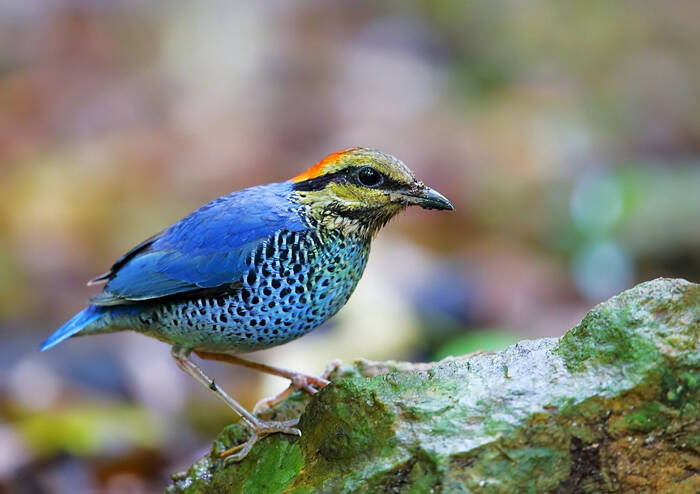Pitta cyanea
IUCN
LCBasic Information
Scientific classification
- name:Pitta cyanea
- Scientific Name:Pitta cyanea,Blue Pitta,
- Outline:Songbird
- Family:Passeriformes Pittidae Pitt
Vital signs
- length:About 22 cm
- Weight:About 109g
- lifetime:9-11年
Feature
The call is like a "pleoow-whit" sound like flowing water
Distribution and Habitat
Distributed in Bhutan in the southeast of the Himalayas, eastern Assam in northeastern India, Myanmar, southern Vietnam in the Indochina Peninsula, northeastern and central Laos, northern, southeastern and western Thailand. In China, it is only distributed in Jinghong, Xishuangbanna in southern Yunnan.
It lives in tropical rainforests, in the shade and wet places under evergreen broad-leaved forests at an altitude of 700-1500 meters or in the bushes beside valley forests.
Appearance
The body feathers of the male blue thrush are similar to those of the female bird, and the head is more colorful. The central crown pattern from the base of the forehead to the occipital part is black, the forehead is narrow, the top of the head is broad, and the crown pattern is ocher gray on both sides. , rendering golden yellow, the color gradually becomes thicker from front to back, the back of the head to the neck is all golden red; the eyes, the lower part of the eye rims and the upper part of the ear area are all black, forming a wide black line behind the eyes extending to the side of the neck . The chin and throat are white, and the black feathers on the side of the throat are thick, forming a significant black mustache pattern, mixed with small white spots, and the lower throat is pure white. The upper body is all bright blue, only the wingtips of the two wings are dark brown, which is more obvious from other eight-color thrushes. The black and white horizontal spots on both
Details
Blue Pitta, also known as Blue Pitta, has three subspecies.

Blue Pitta runs on the ground, foraging for food, and feeds mainly on insects such as beetles. They are resident birds and rarely fly. In the Indian subcontinent, due to the local seasonal climate, there is a phenomenon of short-term migration. It lives in evergreen forests, semi-deciduous forests and bamboo groves. It has the characteristics of a pitta. Its call is like a "pleoow-whit" sound like flowing water. It makes a rough wheeze "skyeew" when warning.
The breeding season of the blue pitta varies from region to region. In Myanmar, the egg-laying season is mainly from May to July, in Thailand it is from August to September, and in the Indian subcontinent it is from mid-September to October at the latest. Generally, it chooses the middle or end of the rainy season. Most of the nests are built in high-humidity forests, on mosses and ferns on very deep and steep gullies, rocky cliffs, and boulders in the forest area. But it does not look like a traditional nest and is difficult to identify.
In India, the nest built by the Blue Pitta is like a loose ball with an entrance, mainly made of grass, tree roots, moss and lichen. In areas dominated by bamboo, bamboo leaves account for a large proportion of the main components of the nest. The shape of the bird's nest is like a round ball with a side door. They are located on nearby embankments. In other areas, the nest is installed at different heights from the ground, ranging from 2.50 meters to 4 meters. Each nest lays 4-5 eggs, up to 7 eggs. The color varies from light red, dark purple or white.
Listed in the 2013 Red List of Endangered Species of the World Conservation Union (IUCN) ver3.1-Least Concern (LC).
Listed in the second level of the "List of National Key Protected Wildlife in China".
Protect wild animals and eliminate game.
Maintaining ecological balance is everyone's responsibility!








